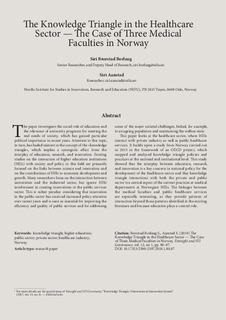| dc.description.abstract | The paper investigates the social role of education and the relevance of university programs to the real needs of society, which has gained especial political importance in recent years. Attention to this topic, in turn, has fueled interest in the concept of the «knowledge triangle», which implies a synergistic effect from the interplay of education, research, and innovation. Existing studies on the interaction of higher education institutions (HEIs) with society and policy in this field are primarily focused on the links between science and innovation and on the contributions of HEIs to economic development and growth. Many researchers focus on the interaction between universities and the industrial sector but ignore HEIs’ involvement in creating innovations in the public services sector. This is rather peculiar, considering that innovation in the public sector has received increased policy attention over the recent period, and is seen as essential for improving the efficiency and quality of public services and for addressing some of the major societal challenges, linked, for example, to an ageing population and maintaining the welfare state.
This paper looks at the healthcare sector, where HEIs interact with private industry as well as public healthcare services. It builds upon a study from Norway carried out in 2015 in the framework of an OECD project, which mapped and analyzed knowledge triangle policies and practices at the national and institutional level. This study showed that interplay between education, research, and innovation is a key concern in the national policy for the development of the health sector, and that knowledge triangle interactions with both the private and public sector is a central aspect of the current practices at the medical departments at Norwegian HEIs. The linkages between the medical faculties and public healthcare services are especially interesting, as they provide patterns of interaction beyond those identified in the existing literature and because education plays a central role. | nb_NO |
